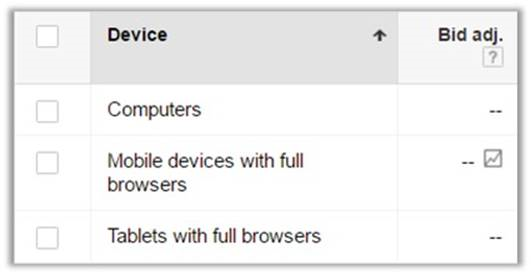As advertisers, we know people designate their various devices for different purposes and, with that, we must attribute different advertising goals to each device. Thankfully, with Google’s updated device bid adjustments system that rolled out across accounts early August, advertisers can now set their base bids for any device and set bid adjustments for the others.
A brief history
Back in 2013, in an attempt to “simplify” the process of advertising on different devices, Google rolled out “enhanced campaigns” which jumbled desktop and tablet bid adjustments together. At the time, they justified their actions by claiming users’ behaviors on desktops and tablets were very comparable. Google also thought this was a way to encourage small businesses to utilize more mobile advertising, since previously this process was viewed as too complicated for businesses based on the people, time and resources needed. Not surprisingly, this decision was met with criticism from the advertising community. It negates the fine-tune targeting and specificities online advertising and online advertisers pride themselves on.
What changes with this new device bidding system?
1) Base bids become device-agnostic
2) Whereas tablets were hidden under the shadows of desktops during the “enhanced campaigns” era, tablet-specific bidding is now available. (Be free, tablets!)

How does this affect advertisers?
It is even more important now for advertisers to analyze device performance across their campaigns. Which device are you seeing a lift in clicks, conversions, leads or any other form of KPI you report on? Do you notice tablets were performing well previously, but couldn’t do anything about it? Well, now you can!
Although desktop has reigned supreme in the advertising world for quite some time now, things are definitely shifting. Most of us have different devices we use for different purposes. Whether a smart phone for Googling anything and everything; a tablet to read or watch your favorite shows; a laptop for online banking or shopping; and possibly even a separate laptop designated as the “work” laptop. These all represent different touch-points where we can encounter advertising. Our consumers are just like us. They own different devices and look to those devices to do different things, and are likely at different stages of the purchase funnel. This means, as advertisers, we must look at the bigger picture of the consumer journey; during the initial research phase, the consumer’s first contact with the brand and each step of journey after that until the transaction is complete. The click that drives the consumer down the purchasing funnel is just as important as the click that finally completes that transaction; and this is where mobile and tablets may edge out desktops.

Now that Google supports device bidding on desktop, mobile and tablet; advertisers have the ability to use their device performance data to more precisely and efficiently target the audience and drive them to perform the desired action. So go forth, analyze, test and optimize your campaigns to your heart’s desire!
P.S. If you are a B2B company still hesitant about advertising on mobile and/or tablet devices, check out this article on our thoughts regarding The Role of Mobile in B2B Marketing. As the world becomes more and more mobile focused, there is definitely a place for mobile and tablets in the B2B advertising space.

M Y M Y N G U Y E N
Search Marketing Analyst, Austin
Sources:
http://searchengineland.com/the-big-adwords-update-enhanced-campaigns-puts-the-focus-on-mobile-147626
http://searchengineland.com/google-adwords-break-tablet-desktop-enable-mobile-base-bid-250214
http://searchengineland.com/use-device-bid-adjustments-straight-google-254380
